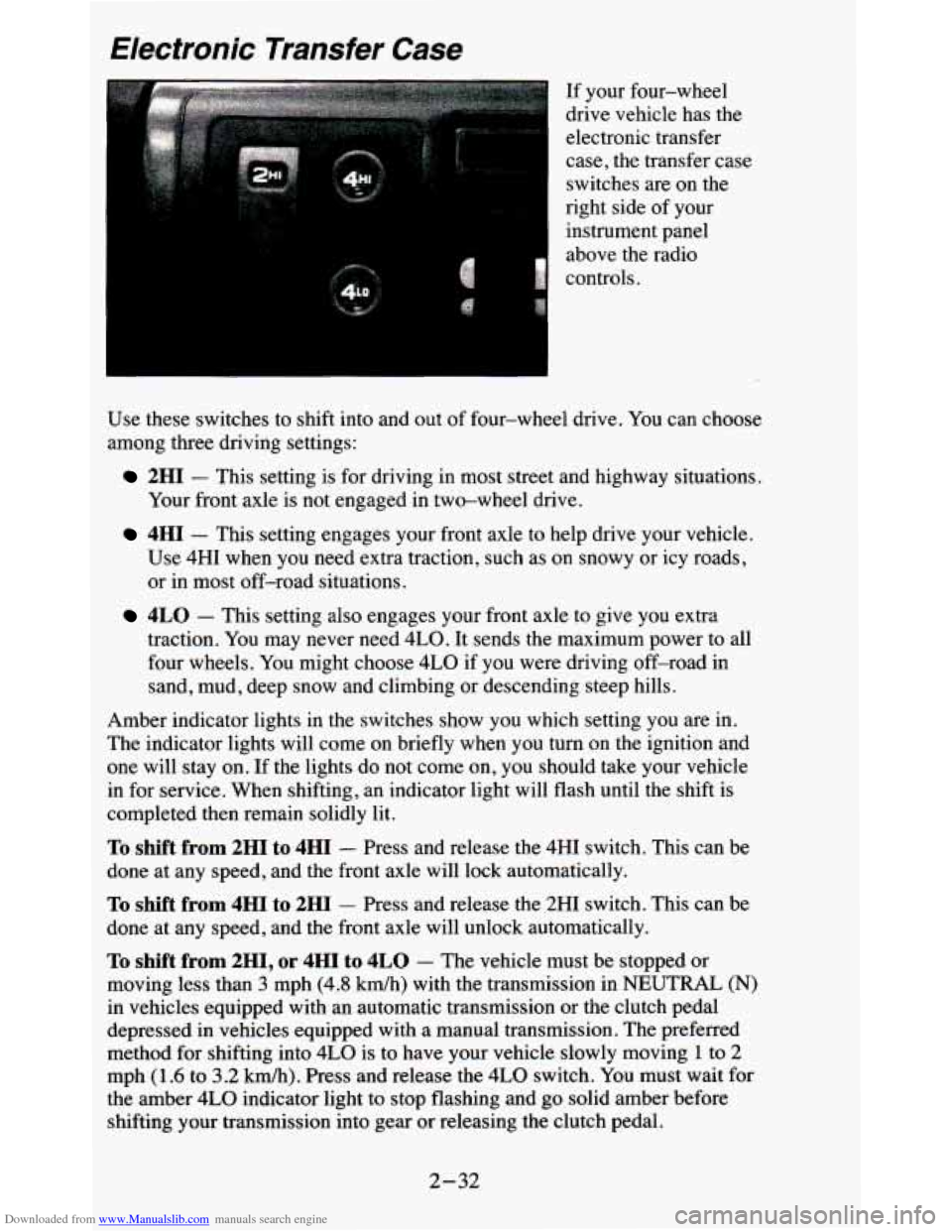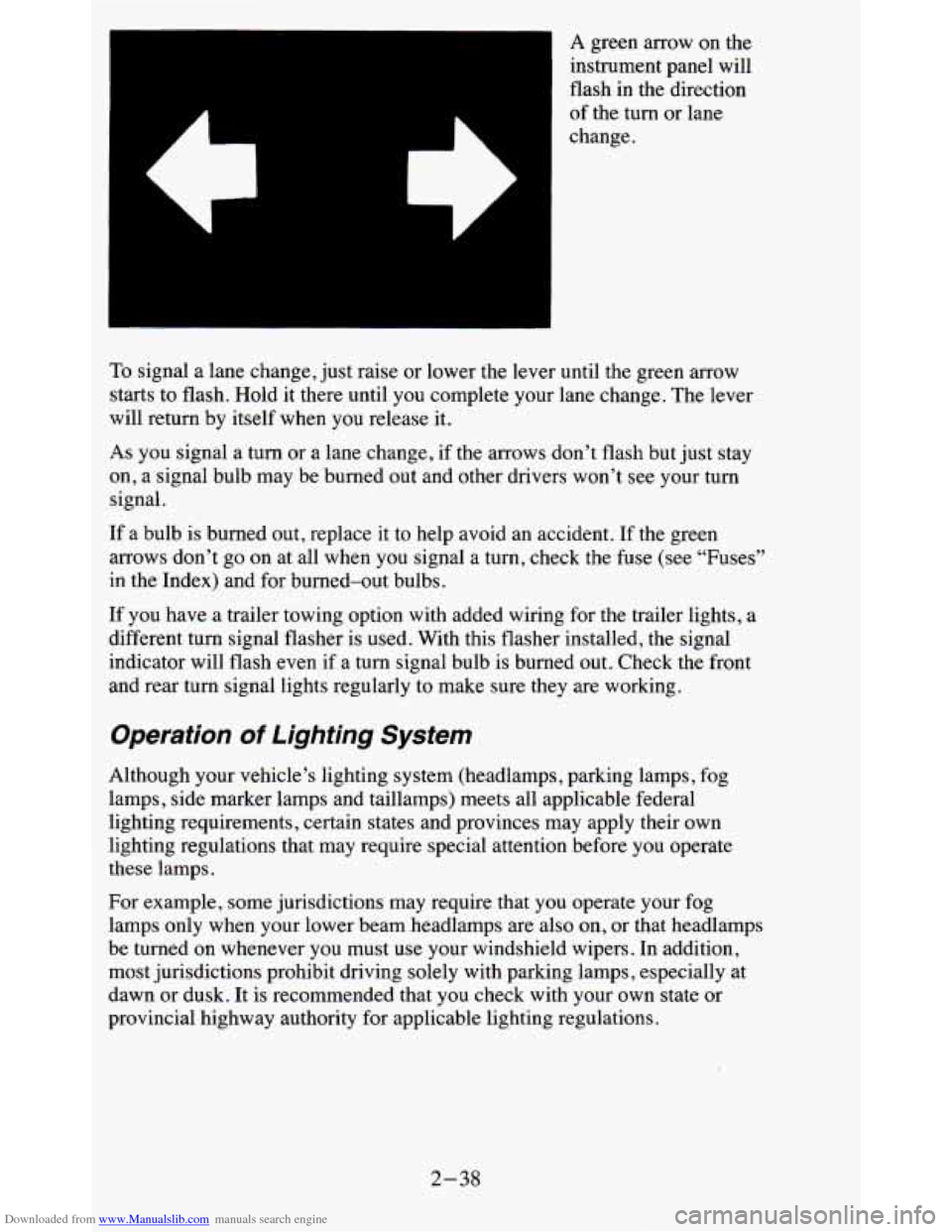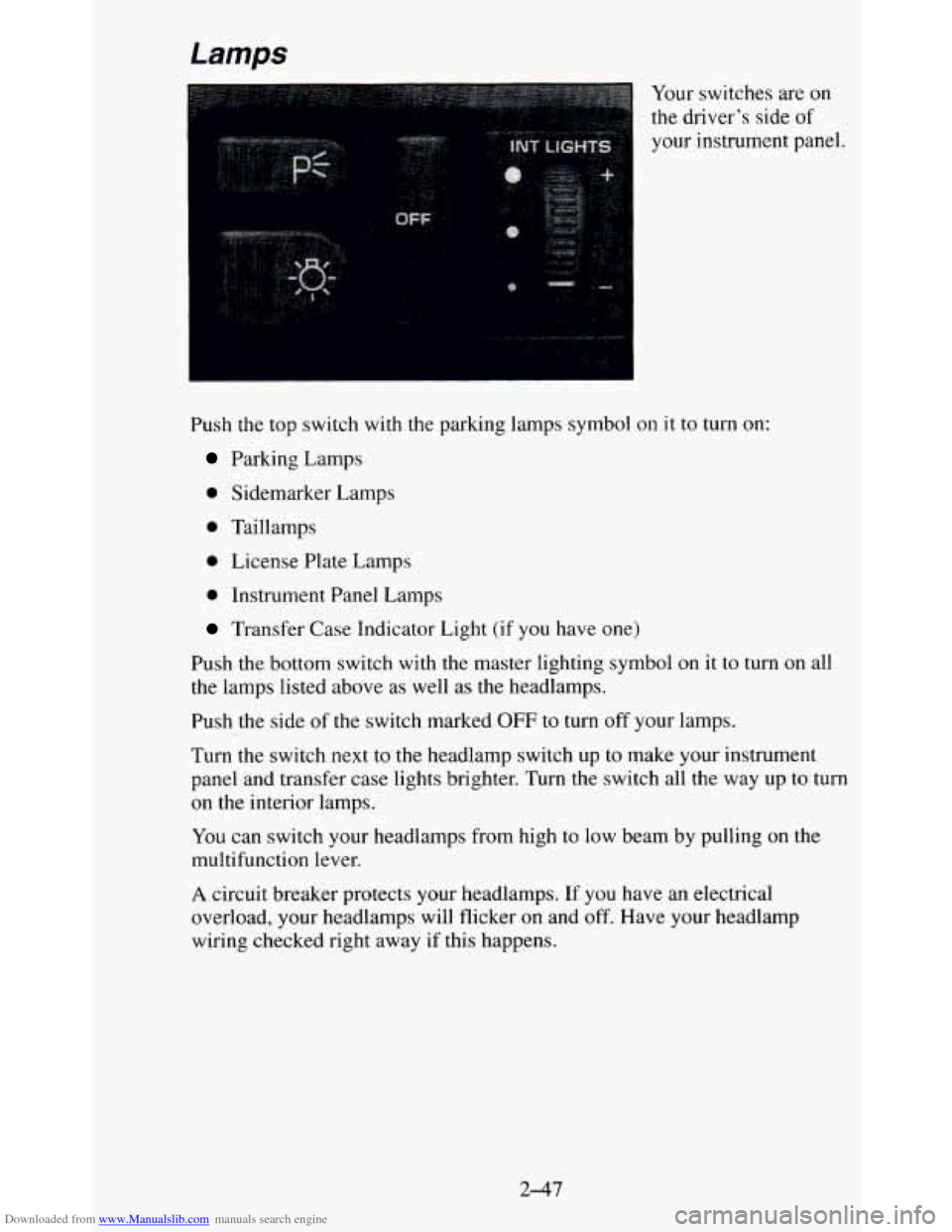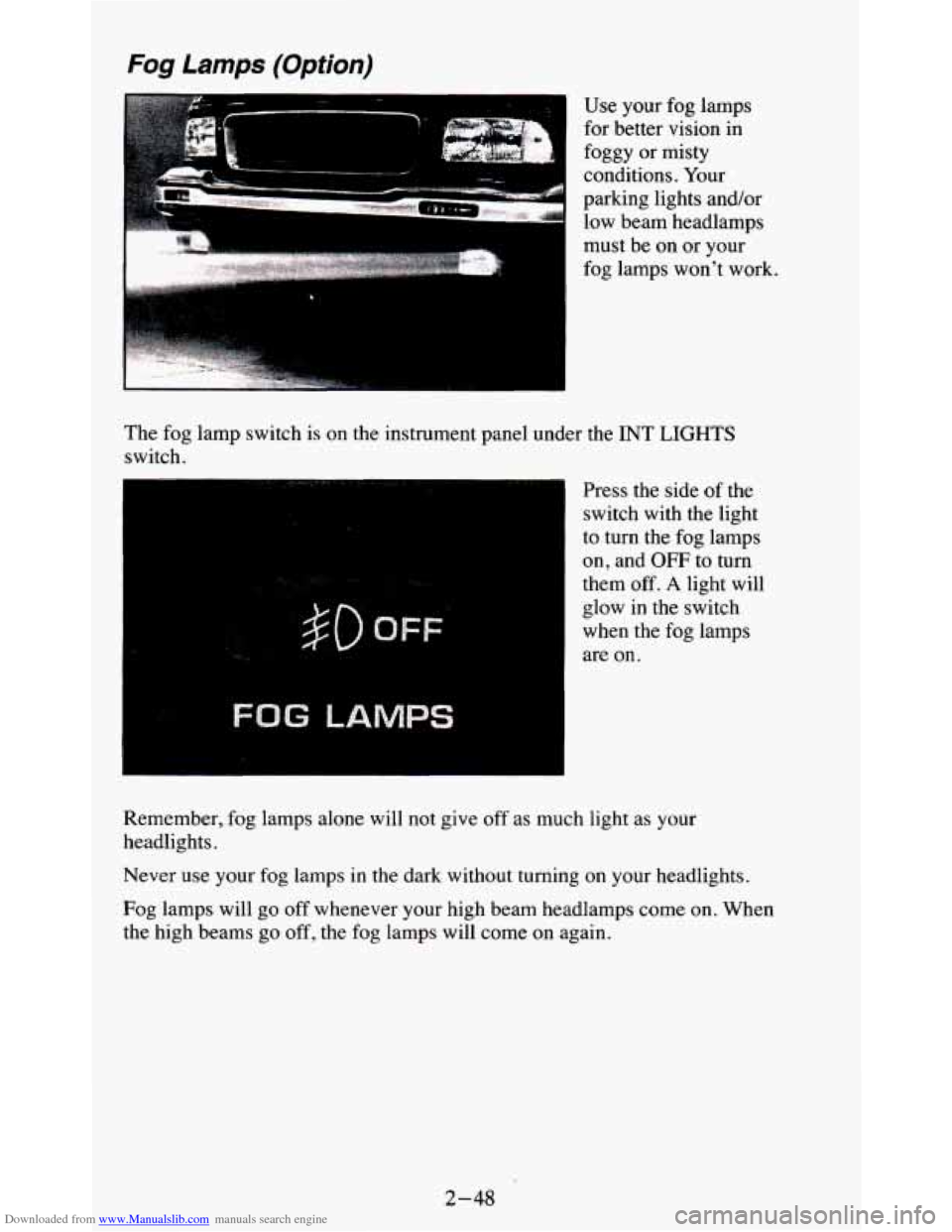1995 CHEVROLET BLAZER lights
[x] Cancel search: lightsPage 9 of 380

Downloaded from www.Manualslib.com manuals search engine These symbols have to do with your lights:
Master Lighting
Switch
I
Parking Lights
- Turn Signal Direction
Daytime
Running Lights
A
Hazard Warning
Rasher
I Fog Lights
These symbols are on some of your controls:
Windshield
Wiper
Rear Window Defogger
Q
0* ew
Windshield Washer
Ventilating Fan
I
Windshield Defroster
0
c Off
Heaulight
High
Beam
Headlight
Low Beam
0% 0%
Rear Window
WiperMasher
vii
Page 10 of 380

Downloaded from www.Manualslib.com manuals search engine These symbols are used on warning and indicator lights:
Engine Coolant
Temperature
I BRAKE
Brake
Battery Charging
System
1
Fuel
SHIFT
Shift Light
1 ANTI-LOCK
I
Anti-Lock Brake
Here are some other symbols you may see:
Fuse Lighter
I-
I-
Horn
L
Engine Oil Pressure
Hood
Release
Vlll ...
Page 82 of 380

Downloaded from www.Manualslib.com manuals search engine Four- Wheel Drive (Option)
If your vehicle has four-wheel drive, you can send your engine’s driving
power to all four wheels for extra traction.
To shift out of two-wheel drive
and
into four-wheel drive, move the transfer case shift lever to 4HI or 4LO.
You should use 2HI for most normal driving conditions, however.
NOTICE:
I
Driving in the 4HI or 4LO positions for a long time on dry or
wet pavement could shorten the life of your vehicle’s drivet\
rain.
Manual Transfer Case
If your four-wheel
drive vehicle has the
manual transfer case,
the transfer case shift
lever
is on the floor
next to the driver. Use
this lever to shift into
and out of four-wheel
drive.
An indicator light near
the lever shows you
the transfer case settings:
0 2HI
4HI
N SET PARK
BRAKE
4LO
The front axle portion of the diagram on the indicator will light up when
you shift into four-wheel drive. A slight delay between shifting and the
pattern’s lighting is normal. If the pattern does not light up, or if the front
axle lights
do not go out after you shift out of four-wheel drive, have your
2-30
Page 83 of 380

Downloaded from www.Manualslib.com manuals search engine dealer check your system. Turn the INT LIGHTS switch located to the righl
of your headlight switch to dim your transfer case indicator light when you1
headlights or parking lights are on. This will also cause your instrument
panel lights to dim.
2HI - This setting is for driving in most street and highway situations.
Your front axle is not engaged in two-wheel drive.
4HI - This setting engages your front axle to help drive your vehicle. Use
4HI when you need extra traction, such as on snowy or icy roads, or in mos
off-road situations.
N SET PARK BRAKE - Shift to this neutral setting only when your
vehicle needs to be towed.
4LO - This setting also engages your front axle to give you extra traction
and provides extra gear reduction. You may never need 4LO. It sends the
maximum power to all four wheels. You might choose 4LO if
you were
driving off-road in sand, mud, or deep snow and climbing or descending
steep hills.
You can shift from 2HI to 4HI or from 4HI to 2HI while the vehicle is
moving.
Do not press the transfer case shift lever button when shifting fron
2HI to 4HI or from 4HI to 2HI. Your front axle will engage faster
if you
take your foot off
of the accelerator for a few seconds after you shift.
To shift your transfer case into N SET PARK BRAKE:
1. Stop the vehicle and shift your transmission into NEUTRAL (N).
2. Set the parking brake. Your vehicle can roll unless the brakes are
3. Pull the transfer case shift lever into N SET PARK BRAKE.
applied.
To shift into or out
of 4LO:
1. The vehicle must be stopped or moving less than 3 mph (4.8 kdh)
with the transmission in NEUTRAL
(N) for an automatic transmission
or the clutch pedal depressed with a manual transmission.
2. Press the transfer case shift button and shift in one continuous motion.
Don’t pause in
N SET PARK BRAKE as you shift into or out of 4L0, or
your gears could clash.
Remember that driving in 4HI or 4LO may reduce fuel economy. Also,
driving in four-wheel
drive on dry pavement could cause your tires to wea
faster and make your transfer case harder to shift and reduce powertrain
longevity.
2-31
Page 84 of 380

Downloaded from www.Manualslib.com manuals search engine Electronic Transfer Case
If your four-wheel
drive vehicle has the
electronic transfer
case, the transfer case
switches are on the
right side of your
instrument panel
above
the radio
controls.
Use these switches to shift into and out
of four-wheel drive. You can choose
among three driving settings:
2HI - This setting is for driving in most street and highway situations.
Your front axle is not engaged in two-wheel drive.
4HI - This setting engages your front axle to help drive your vehicle.
Use 4HI when you need extra traction, such as on snowy or icy roads,
or in most off-road situations.
4LO - This setting also engages your front axle to give you extra
traction. You may never need 4LO. It sends the maximum power to all
four wheels. You might choose
4LO if you were driving off-road in
sand, mud, deep snow and climbing or descending steep hills.
Amber indicator lights
in the switches show you which setting you are in.
The indicator lights will come on briefly when you turn on the ignition and
one will stay on. If the lights do not come on,
you should take your vehicle
in for service. When shifting,
an indicator light will flash until the shift is
completed then remain solidly lit.
To shift from 2HI to 4HI - Press and release the 4HI switch. This can be
done at any speed, and the front axle will lock automatically.
To shift from 4HI to 2HI - Press and release the 2HI switch. This can be
done at any speed, and the front axle will unlock automatically.
To shift from 2H1, or 4HI to 4LO - The vehicle must be stopped or
moving less than
3 mph (4.8 km/h) with the transmission in NEUTRAL (N)
in vehicles equipped with an automatic transmission or the clutch pedal
depressed
in vehicles equipped with a manual transmission. The preferred
method for shifting into
4LO is to have your vehicle slowly moving 1 to 2
mph (1.6 to 3.2 km/h). Press and release the 4LO switch. You must wait for
the amber
4LO indicator light to stop flashing and go solid amber before
shifting your transmission into gear or releasing the clutch pedal.
2-32
Page 90 of 380

Downloaded from www.Manualslib.com manuals search engine A green arrow on the
instrument panel will
flash
in the direction
of the turn or lane
change.
To signal a lane change, just raise or lower the lever until the green arrow
starts to flash. Hold it there until you complete your lane change. The lever
will return by itself when you release it.
As you signal a turn or a lane change, if the arrows don’t flash but just stay
on, a signal bulb may be burned out and other drivers won’t see your turn
signal.
If a bulb is burned out, replace it to help avoid an accident. If the green
arrows don’t go on at all when
you signal a turn, check the fuse (see “Fuses”
in the Index) and for burned-out bulbs.
If you have a trailer towing option with added wiring for the trailer lights, a
different turn signal flasher is used. With this flasher instal\
led, the signal
indicator will flash even if
a turn signal bulb is burned out. Check the front
and rear turn signal lights regularly to make sure they are w\
orking.
Operation of Lighting System
Although your vehicle’s lighting system (headlamps, parking lamps, fog
lamps, side marker lamps and taillamps) meets all applicable federal
lighting requirements, certain states and provinces may apply their own
lighting regulations that may require special attention before you operate
these lamps.
For example, some jurisdictions may require that you operate your fog
lamps only when your lower beam headlamps are also on,
or that headlamps
be turned on whenever you must use your windshield wipers. In \
addition,
most jurisdictions prohibit driving solely with parking lamps, especially at
dawn or dusk. It is recommended that you check with your own state or
provincial highway authority for applicable lighting regulations.
2-38
Page 99 of 380

Downloaded from www.Manualslib.com manuals search engine Lamps
Push the top switch with the parking lamps symbol
Parking Lamps
0 Sidemarker Lamps
0 Taillamps
0 License Plate Lamps
0 Instrument Panel Lamps Your
switches are
on
the driver’s side of
your instrument panel.
on it
to turn on:
Transfer Case Indicator Light (if you have one)
Push the bottom switch with the master lighting symbol
on it to turn on all
the lamps listed above as well as the headlamps.
Push the side
of the switch marked OFF to turn off your lamps.
Turn the switch next to the headlamp switch up to make your \
instrument panel and transfer case lights brighter. Turn the switch all the way up to turn
on the interior lamps.
You can switch your headlamps from high to low beam by pulling on the
multifunction lever.
A circuit breaker protects your headlamps. If you have an electrical
overload, your headlamps will flicker on and
off. Have your headlamp
wiring checked right away if this happens.
2-47
Page 100 of 380

Downloaded from www.Manualslib.com manuals search engine Fog Lamps (Option)
Use your fog lamps
for better vision in
foggy or misty
conditions. Your
parking lights and/or
low beam headlamps
must be on or your
fog lamps won’t work.
The fog lamp switch is on the instrument panel under the INT
LIGHTS
switch I
$0 OFF-
FOG LAMPS
Press the side of the
switch with the light
to turn the fog lamps
on, and OFF
to turn
them
off. A light will
glow
in the switch
when the fog lamps
are on.
Remember, fog lamps alone will not give
off as much light as your
headlights.
Never
use your fog lamps in the dark without turning on your headlights.
Fog lamps will
go off whenever your high beam headlamps come on. When
the high beams go
off, the fog lamps will come on again.
2-48